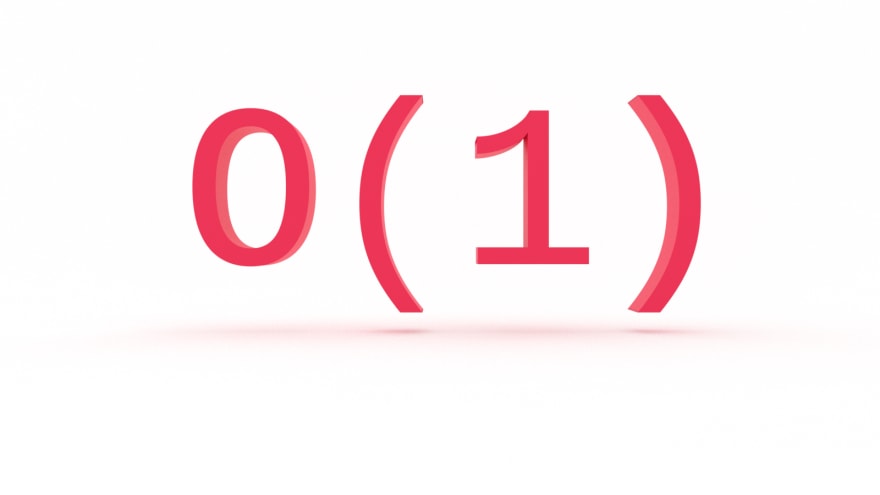Is there a computer science topic more terrifying than Big O notation? Don’t let the name scare you, Big O notation is not a big deal. It’s very easy to understand and you don’t need to be a math whiz to do so. In this tutorial, you'll learn the fundamentals of Big O notation, beginning with constant and linear time complexity with examples in JavaScript.
Note: Amazon links are affiliate.
This is the first in a series on Big O notation. If you want to stay in the loop, sign up for my weekly newsletter, The Solution.
What Problem(s) Does Big O Notation Solve?
Big O notation helps us answer the question, “Will it scale?”
Big O notation equips us with a shared language for discussing performance with other developers (and mathematicians!).
What is Big O Notation?
Big O is a notation for measuring the performance of an algorithm. Big O notation mathematically describes the complexity of an algorithm in terms of time and space. We don’t measure the speed of an algorithm in seconds (or minutes!). We measure the rate of growth of an algorithm in the number of operations it takes to complete.
The O is short for “Order of magnitude”. So, if we’re discussing an algorithm with O(n), we say its order of magnitude, or rate of growth, is n, or linear complexity.
You will probably read or hear Big O referred to as asymptotic runtime, or asymptotic computational complexity. This is a fancy way of describing the limits of a function. There is a branch of mathematics, order theory, devoted to this topic. For our intents and purposes, order:
… provides a formal framework for describing statements such as "this is less than that" or "this precedes that".
We use order to evaluate the complexity of our algorithms.
Math O’Clock 🧮 🕐
You don’t need to be a math whiz to grok Big O, but there are a few basic concepts we need to cover to set you up for success.
If you recall from algebra, you worked with functions such as f(x) and g(x), and even did things like f(g(x)), where f() and g() were equations and x was a numerical value (or another equation!) passed to the functions.
When we’re programming, we give our “equations” descriptive names (at least I hope you are), such as isAuthenticated and calcuateMedian, but we could also name them f and g (please don’t).
Let’s say f(x) is equal to 3x2 + 12x - 6.
We could say that the order of magnitude, or rate of growth, of f(x) is O(n2). We’ll see why later.
It’s more common to simply say “f(x) is order of n2”, or “f(x) is Big O of n2”.
Math time over.
For now. 😀
How Does Big O Notation Work?
Big O notation measures the worst-case runtime.
Why?
Because we don’t know what we don’t know.
If we’re writing a search algorithm, we won’t always know the query ahead of time. If we’re writing a sorting algorithm, we won’t always know the dataset ahead of time. What if the query is the very last element or what if the dataset is a real mess. We want to know just how poorly our algorithm will perform.
The worst-case scenario is also known as the “upper bound”. Limits again!
You’re going to encounter a lot of tables like this:
| O | Run time | |
|---|---|---|
| O(1) | constant | fast |
| O(log n) | logarithmic | |
| O(n) | linear | |
| O(n * log n) | log linear | |
| O(n2) | quadratic | |
| O(n3) | cubic | |
| O(2n) | exponential | |
| O(n!) | factorial | slow |
This lists common runtimes from fastest to slowest.
We’ll refer to this a lot as we proceed.
Before we get into any code, let’s get hands-on to get a feel (pun intended) for Big O. We’ll use an example from Grokking Algorithms.
Let's say I give you a square piece of paper and ask you to divide it into sixteen squares. How would you approach this problem?
You could take the brute force approach and draw sixteen individual squares. If you take this approach, how many steps, or computations, will you perform?
Sixteen.
Is there an approach that requires fewer steps? Of course!
Fold the paper in half. Then in half again. Four squares!
Now fold it in half two more times.
When you unfold it, the paper will be divided into sixteen squares.
How many steps, or computations, were required?
Four.
In Big O notation, our first approach, brute force, is O(n), or linear time. Creating sixteen squares requires sixteen operations. But our second, refactored and optimized, approach is O(log n), or logarithmic time (the inverse of exponentiation). Creating sixteen squares requires only four steps.
We’ll look at O(log n) later. Let’s begin with O(1), which will help us understand O(n).
O(1): Constant Time Complexity
Say you’re working with an API that returns a users full name in an array, like so:
[“Jared”, “Nielsen”];
Your task is to get the users first name. Easy, in JavaScript:
const getFirstName = data => {
return data[0];
}
No matter how many times you run your ‘algorithm’, it only needs to perform one operation to return the desired value. That’s O(1), or constant time.
Here’s another JavaScript example:
const isEven = num => num % 2 === 0;
Our algorithm checks whether or not a number is even or odd and will return true or false accordingly. It only needs to perform one operation. Again, O(1).
What is Big O Notation?
Big O notation is not a big deal. It’s very easy to understand and you don’t need to be a math whiz to do so. In this tutorial, you learned the fundamentals of Big O notation, as well as constant and linear time complexity with examples in JavaScript.
Stay tuned for part two of this series on Big O notation where we'll look at O(n), or linear time complexity. If you want to stay in the loop, sign up for my weekly newsletter, The Solution.




















